How coaches can quickly set up coaching products in ConvertKit Commerce
Length: • 10 mins
Annotated by Jason
Most creators don’t build an online business so they can work harder and longer.
They build an online business because digital platforms make it simple to scale with tools like email marketing software that comes with automations and integrations.
But what if your online business requires your presence? Your one-on-one consultation? Your focused expertise? For coaches, that presents a challenge. There’s only one dial you can shift to move the scale: price. And a price point that’s too high can send potential clients looking for the exits.
ConvertKit Commerce is a platform for monetizing your services—think eBooks, newsletters, music, software presets, and, yes, coaching.
The secret to scaling your business as a coach is productization. Rather than offering a custom experience, you can treat each coaching session as a unique product. For example, maybe you’ll offer a package that requires a minimum of four coaching sessions.
Put the right systems in place with ConvertKit Commerce, and you can automate more aspects of even the most service-based businesses. With platforms for advertising, selling, and scheduling your available time, you can watch coaching slots fill up without constantly hounding people. You can even build products that earn sales without demanding more time.
It might sound complicated. But long-term, productizing your coaching business is the simplest approach. That’s if you know how to approach it. So let’s dive into the steps for running your coaching business more like a product business:
How to start selling with ConvertKit Commerce in one day
The good news: you can start selling on ConvertKit Commerce in one day. A four-step setup process will walk you through naming your coaching services, choosing pricing styles (flat fee or recurring payments? Payment plans or tip jars?), and integrating the ordering process with your coaching business.
Tie it all together with your ConvertKit community, like an existing newsletter, and you have the recipe for new revenue streams within a day.
But if you want a successful launch, it doesn’t hurt to hit the “rewind” button and figure out what’s worth selling. In this section, we’ll address all three phases:
- Ideation: What will you sell?
- Audience building: Who are you selling to?
- Launching: How will you get from zero to a finished product on ConvertKit Commerce?
The idea phase: selling what you know
This is where many coaches get stuck. They know they have specific expertise. They know that if a client asks a question, they can respond with something helpful. But if you build a passive income product that doesn’t require this one-on-one interaction, you can earn money while you sleep.
The question that stumps many coaches is the form your product should take. What’s the ideal medium for content delivery? Do you do best with one-on-one coaching sessions? If so, a video course will likely work. Do you prefer to send thorough, comprehensive emails? A newsletter or eBook might be more your speed. Or you may have the best results incorporating both with a multimedia product.
The other challenge of the ideation phase is you might not feel like you have a unique angle that works as a repeatable coaching product. It’s the difference between being a fitness coach and selling “Seven-Minute Abs.” If you want to find your unique selling point, here are some tips for turning your coaching into great content ideas:
You have a unique skill set—so sell it
Carrie Olsen was so quiet growing up that many adults assumed she couldn’t talk. But one day, she was listening to a podcast interview with a voice actor, and the idea of earning from home was too good to pass up. Olsen reached out to that voice actor and signed up for her coaching program. With four months of diligent studying and following Steel’s advice to the letter, Olsen had a full-time income.
For many people, that would be the end of the story. But Olsen’s transformation was so sudden people wondered how she’d pulled it off.
Olsen realized she’d acquired another skill in making her voice acting career work. She’d learned how to grow a career from the ground up. Rather than coaching people on how to do voice-overs, she created a course that taught people to replicate her results. Then she found people were still fascinated by her insights and wanted more. That led her to coaching.

Her voiceover career now sees nearly one-third of all revenue land passively through sales of online courses. She also generates income with one-on-one coaching sessions that she manages through ConvertKit Commerce. All because she did more than figure out something for herself. She figured out the skillset she possessed, which she could share with others.
Give out the advice you needed three years ago
If Olsen had a time machine, she likely would have been her own coach. But that’s one key to figuring out what you can do to help others like you. Go back about three years ago, then consider the advice you’d give yourself.
Chances are, there’s someone out there who needs the same coaching.
Creator Jenell Stewart went through a similar process. For decades, she had been chemically relaxing and straightening her hair. Then one night, she went down the YouTube wormhole and discovered women embracing the “Big Chop”—starting over and letting their natural hair grow out.

She started creating videos about her experience, eventually landing the attention of sponsors and a hefty audience of over 100,000 YouTube subscribers. And along the way, she picked up some additional skills that she now uses in her products. She even coaches her daughter in content creation.
Jenell didn’t invent the idea of the Big Chop. She simply saw the advice she needed three years ago and started giving it out online.
Jenell had one more secret in her arsenal: rapid iteration. She was constantly testing new content—and learning on the job.
Two years and 56 videos later, she got her first message from a company looking to hire her as a brand ambassador.
She didn’t even have a proper laptop when starting, Jenell says. But despite the technical challenges, she put out content anyway. And she got better at it. “Making a YouTube video is like making a peanut butter and jelly sandwich,” she said, looking back on her career.
You’ll have to test out what resonates with your audience, too.
- Which topics generate the most engagement? Why do they generate that engagement, and what kind of comments do you get on them?
- Try testing out a few “broad categories” with social media posts first, then whittle down as you see which way your audience leans.
Launching a service and building an audience
Getting online isn’t the challenge. You can be up and running within a day with a YouTube channel, Twitter account, and ConvertKit Commerce platform.
The question is: who’s going to listen?
Here are some principles to audience building, so you have people who want your coaching in the first place:
- Build around authenticity. Your unique experiences are what shape your angle. They’re why people resonate with your story—and not the next coach’s. Take the example of Vannessia Darby, a piano teacher. One would think piano lessons don’t necessarily intersect with stories about micro-aggressions. But Darby tells those stories, too, and her audience loves her all the more for it.
- Build your offer. What do you bring to the table as a coach? It’s not enough to list your niche—say, “piano lessons”—and call it a day. Get clear about the benefits of working with you. Do you offer piano lessons for busy kids? Busy parents? Piano lessons for people 55+ who never had a musical ear? This will result in a more engaged audience simply because people won’t know where to find more people like you.
- Write a strong social media profile. Once you know your specific coaching offer, incorporate it into your social media profiles. Every time someone visits your profile because someone shared one of your posts, this is like a miniature audition for clients. Follow this format: Position (what you do) + Who benefits from it + Additional links and CTA. For example: “The 55-and-older Piano Coach. Helping people with no musical talent rekindle their love for playing. Visit my post at...”
How to set up ConvertKit Commerce in one day
Create a ConvertKit account. You’ll see all sorts of options for building your newsletter list. But let’s assume you already have an audience ready to go. What you want to do today is set up your coaching products to make sales on your behalf without you having to lift a finger. Here’s what you do:
Set Up a Product

This will take you to the Product Details tab. Here’s where you input the product name and price. (At this point, you can enter placeholders—you can always edit them later. Don’t get too hung up on the specifics.)
You’ll also notice a choice at this stage. You can choose a Product, with a one-time fee, or a Subscription, which sets up a recurring fee. It’s completely up to you which you choose. For example, some coaches opt for Subscriptions for community memberships but may use Products for eBooks or video courses.
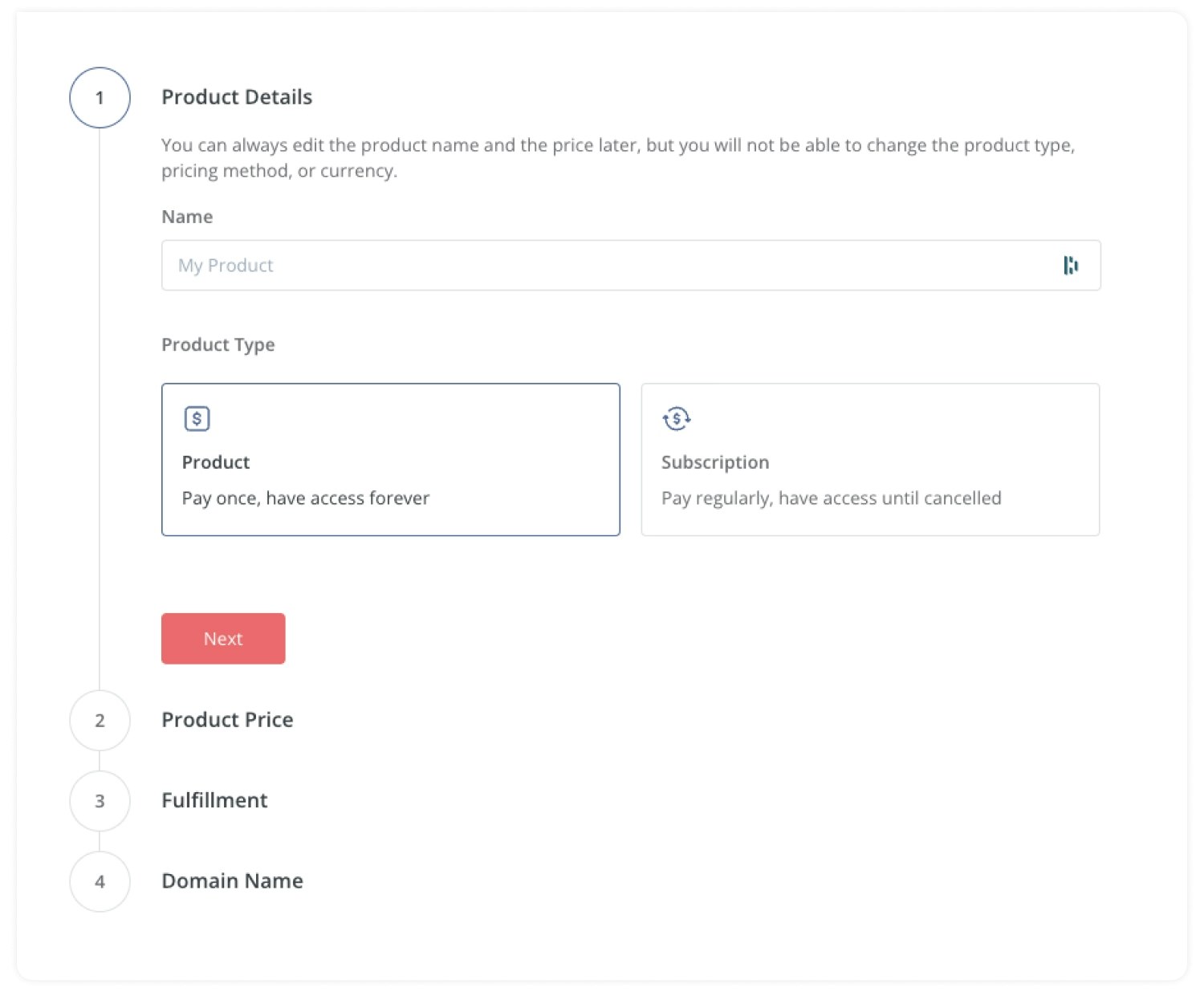
Determine Pricing
In the second step, you can set up product pricing according to three rules:
- Standard: One purchase price, one-time purchase. This is how most of us think about buying something—like an eBook or downloading an album.
- Pay what you want: This is a great way to build authenticity and a reputation for offering value—let customers decide what to pay. You’ll make less money, but you’ll attract a following.
- Payment plans: If you have a high-priced item to give away or simply want to make your coaching products more affordable, customers often appreciate longer-term payment plans where you split the price into monthly installments.
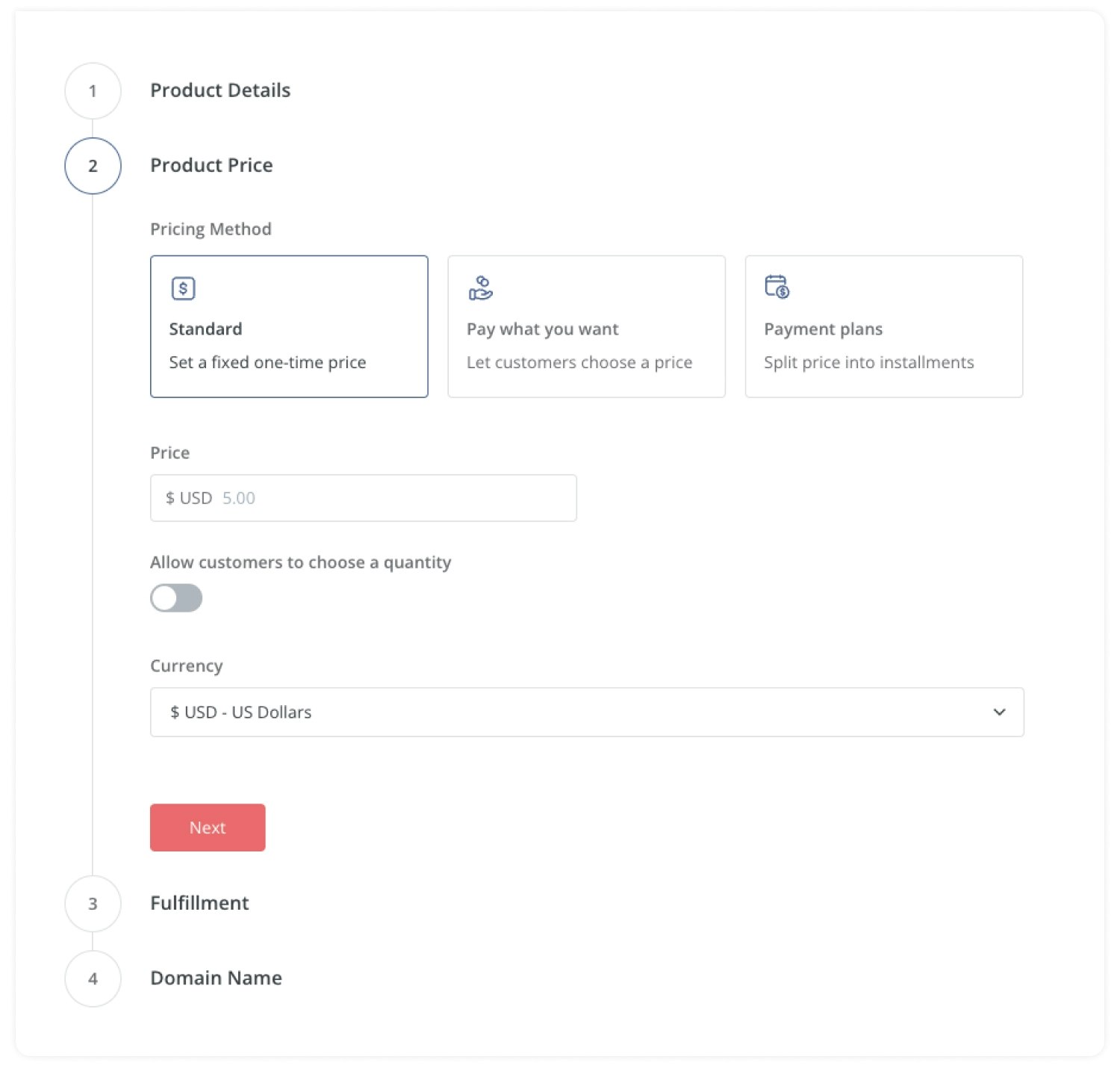
Add Your Product
At the “Fulfillment” stage is when your coaching products may veer from the traditional path. You can upload videos, eBooks, audio files, etc. But if you click Something Else, you can productize your coaching services.
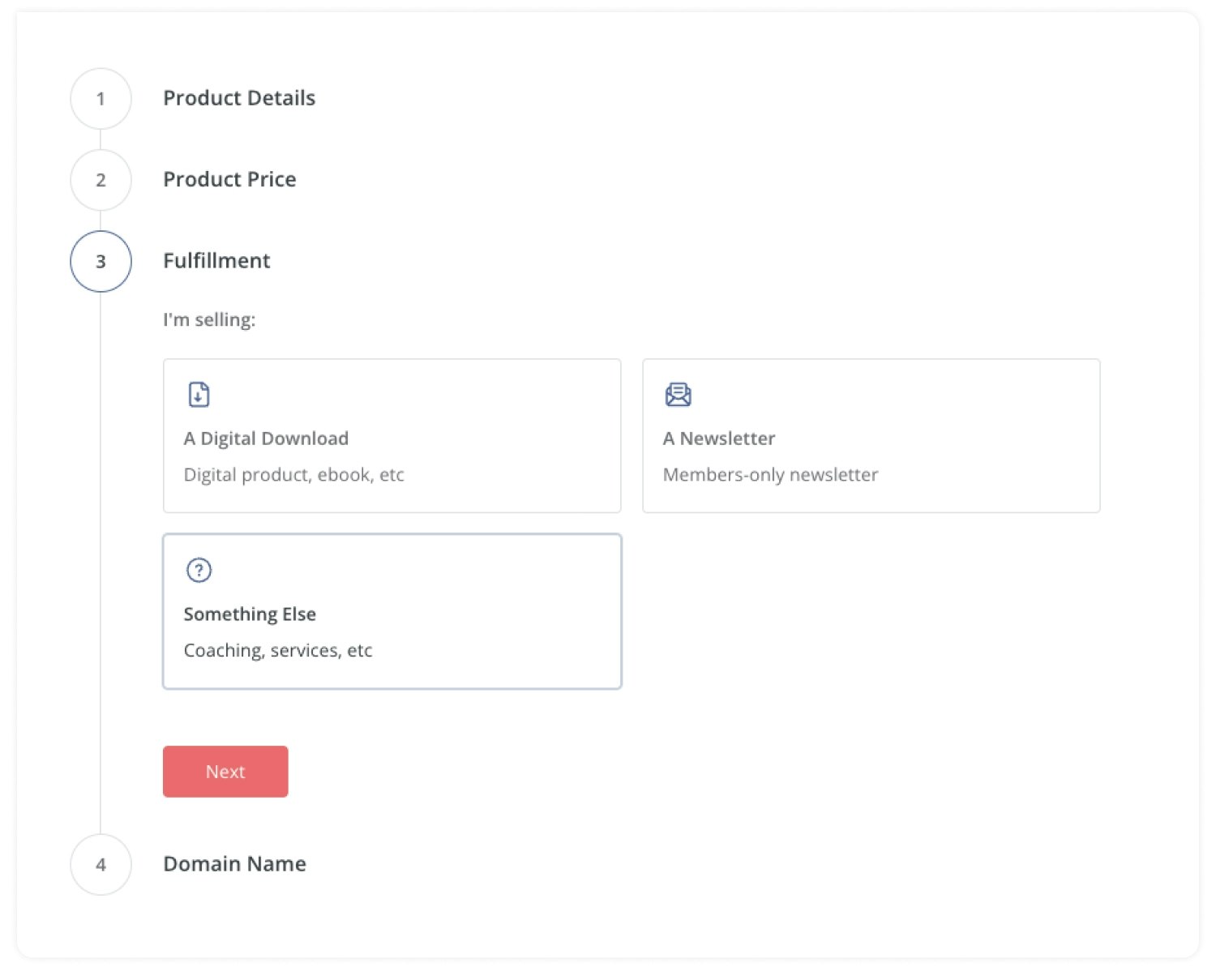
ConvertKit will then lead you to create a site for your product. Click through, and ConvertKit will take you to the page editor. Here’s where you can build the customer-facing purchase section.
(Note: if you still want to edit pricing, the name of your product, or other details, just click Settings on this page.)
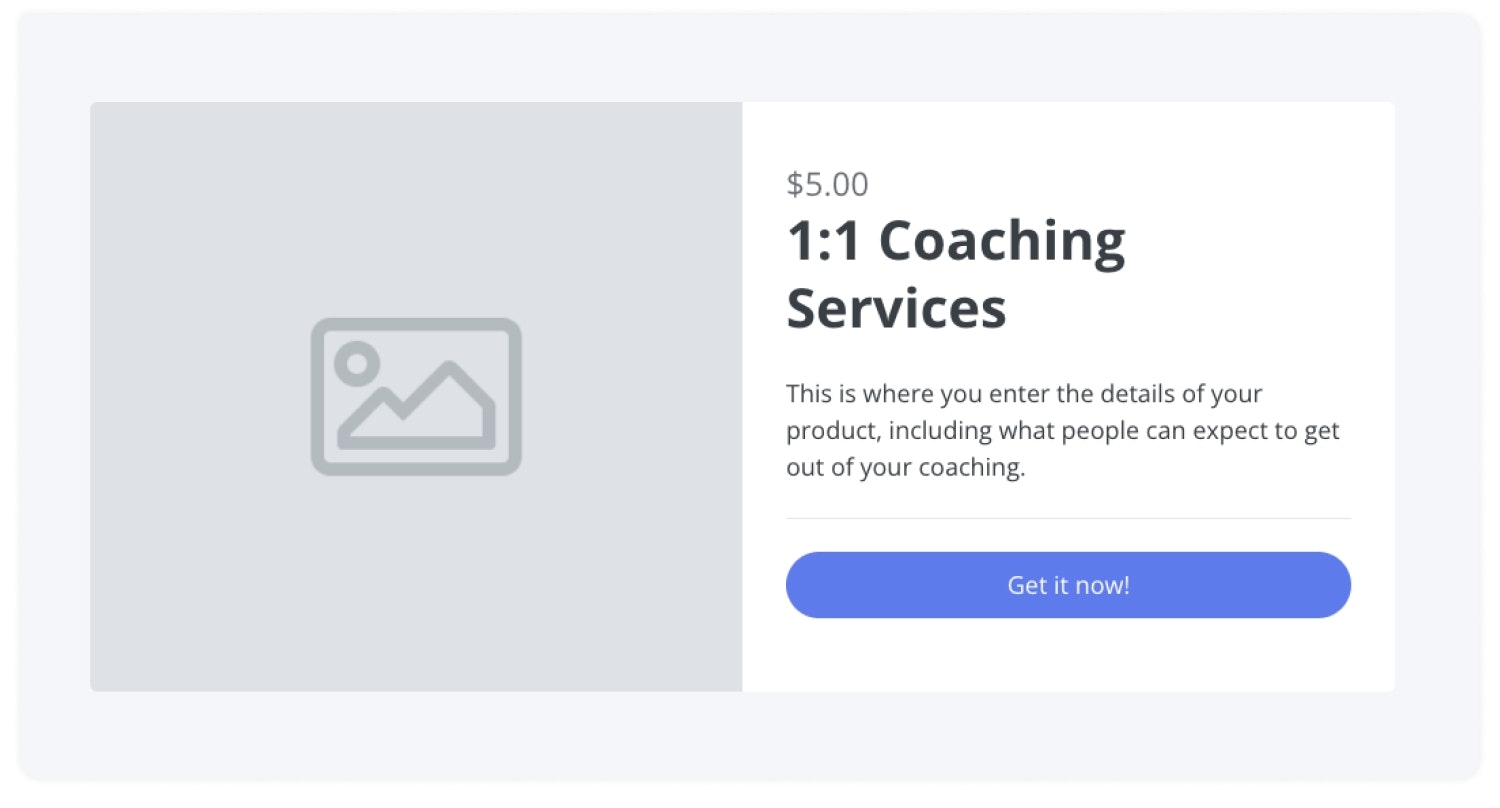
You can customize your coaching product, such as offering a 1-hour coaching session at a fixed price or a recurring monthly coaching session on an installment plan. Or you can productize your coaching by uploading alternative files—eBooks, audio, video courses, etc.
What creators say about launching coaching products
Jay Clouse once turned to Twitter with an idea. He could spend 40 minutes overlooking his customers’ online presence, then deliver a Loom with his brutally-honest feedback.
Thinking about offering a service called something like “Brutally Honest Audit.”
I spend 40 minutes looking over your online presence & recent work, and then I deliver a Loom with the feedback people are (probably) afraid to tell you but is likely holding you back.
Thoughts?
The Tweet was an instant hit. “Immediately, people told me they’d buy it,” Clouse said. “So I decided to see if people would actually pay for it – and ConvertKit Commerce allowed me to validate that very quickly. No question, ConvertKit Commerce is the fastest way I’ve found to spin up a good-looking sales page. It’s so simple, and within minutes I could share a sales page for the product.”
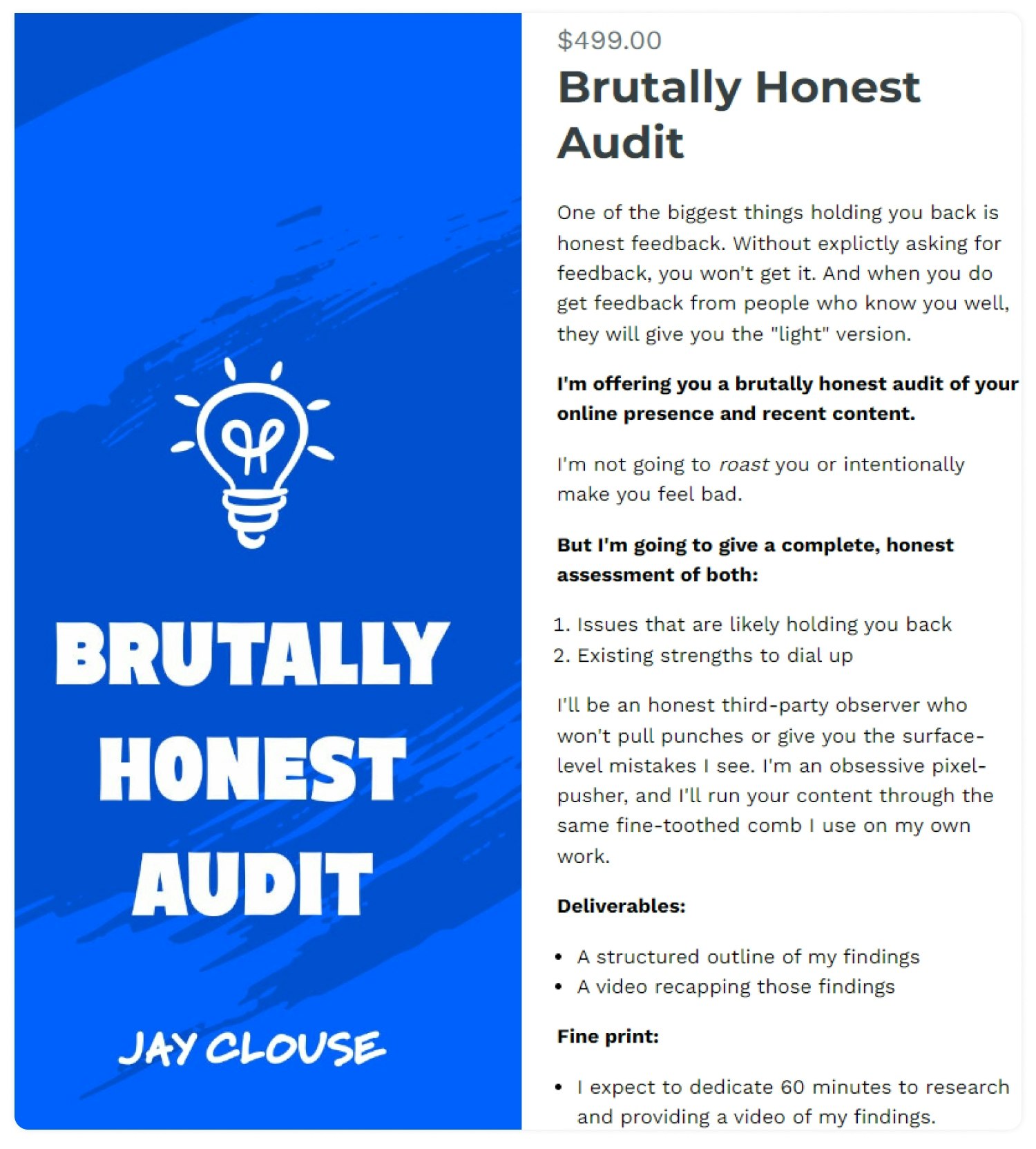
Within an hour of sharing the idea and directing people to the sales page, Clouse booked $6,000 worth of work. And he credits the speed of ConvertKit Commerce to those numbers. “A lot of it is due to being able to capture the excitement that people had from the idea quickly,” he said.
It hasn’t just been the initial burst, either. Clouse says he’s been working on ConvertKit Commerce for a few years, generating over $32,000 in sales from the landing pages he’s set up.

Other creators also report they love the speed of ConvertKit Commerce. Rachel Jimenez of Prosperous Media Group says she wasn’t even planning on offering coaching services—yet still managed to earn money from it.
“I don’t usually do 1:1 coaching,” said Jiminez. “I didn’t market my services but I’ve had some good press lately, and some people have reached out to me and asked for coaching sessions. So I was like, ‘I’m not going to turn them away,’ and quickly set up a Commerce product for handling payments.”
She did. The results? “When I got a few requests, I was able to set up a form to look professional in ConvertKit and send people the link within minutes,” said Jiminez. “I’ve made about $500, but this was extra income that I wasn’t even trying to make.”
Rachel Bearbower of Small Shop Strategies has seen higher revenue in working directly with coaching clients, but similar ROI—she even reports she doesn’t even have to fire up ConvertKit Commerce too often to drive this revenue.

However, “utilizing [ConvertKit] for its relationship-building capabilities is huge,” Bearbower said. She leans on the entire ConvertKit structure to drive higher-than-average engagement rates, including 6.1% click rates and 43% open rates on her emails. But even without opening ConvertKit Commerce to create new sales pages all that often, she still sees revenue coming in.
Has it worked? “In the last 24 months, I’ve earned about $20,500 in revenue through ConvertKit Commerce,” Jiminez said.
ConvertKit Commerce makes it easy to sell digital products from the same platform you use to send your emails. You can use it to test out all sorts of methods—from different pricing plans to variable price points—and identify what works best for your audience.
Does it work? Of course. Take the Daphnee Lagredelle case study. Daphne was an established business coach, working primarily through Facebook as her channel. She started funneling that traffic to lead magnet pages she set up, created automated newsletter onboarding for new subscribers, and used these new home bases to sell 1:1 coaching sessions.
The result? She can now sell event tickets, digital products, coaching packages, and community memberships from the same dashboard, bringing in $100,000 in new revenue.
You can do the same if you have an engaged audience. And having the right platform in place can help get you there. Check out ConvertKit Commerce to use the full features to level up your coaching presence and leverage your business for more revenue.